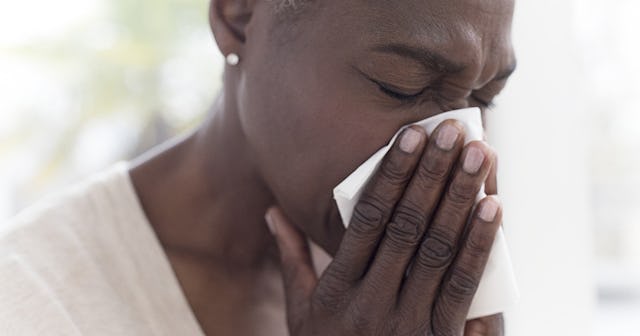The CDC Added 3 More COVID-19 Symptoms To Its Official List

As the number of new COVID-19 cases increase, so does the the Centers for Disease Control and Prevention’s (CDC) list of coronavirus symptoms.
The CDC recently added three more symptoms on its “Symptoms of Coronavirus” list, bringing the total number of possible symptoms to 12. The newly added symptoms (though, not necessarily “new” symptoms as they’ve been pointed out since the beginning of the pandemic) are congestion or runny nose, nausea, and diarrhea. The last time the CDC updated its list was in late April, with the addition of chills, repeated shaking with chills, muscle pain, headache, sore throat, and new loss of taste or smell.
RELATED: 11 Things To Eat And Drink When You Have A Sore Throat (And 6 To Avoid)
Now, the list of possible symptoms includes: fever, chills, cough, shortness of breath or difficulty breathing, fatigue, muscle or body aches, headache, new loss of taste or smell, sore throat, congestion or runny nose, nausea or vomiting, and diarrhea.
“People with COVID-19 have had a wide range of symptoms reported – ranging from mild symptoms to severe illness. Symptoms may appear 2-14 days after exposure to the virus. People with these symptoms may have COVID-19,” the CDC states on their website.
One of the most common questions asked about coronavirus symptoms is knowing whether you simply have allergies or the actual virus, to which Johns Hopkins Medicine says: “Allergies are common in the spring months, and can cause itchy eyes, stuffy nose and sneezing. The common cold can show up with these symptoms and others, such as a low-grade fever or cough. Strep throat is a bacterial illness with symptoms that include a sore throat and fever. COVID-19 shows up most often with fever, shortness of breath and cough.”
Those with COVID-19 symptoms are advised by the CDC to stay home and away from other people. However, those showing any of the CDC’s emergency warning signs — trouble breathing, persistent pain or pressure in the chest, new confusion, inability to wake or stay awake, or bluish lips or face — are advised to seek emergency medical attention immediately.
The CDC also recently added pregnancy to their list of health conditions that may make contracting COVID-19 more serious; the list also includes underlying health conditions and age of patients.
“An MMWR study suggests that pregnant women with COVID-19 are more likely to be hospitalized and are at increased risk for intensive care unit (ICU) admission and receipt of mechanical ventilation than nonpregnant women. Risk of death is similar for both groups. But much remains unknown,” CDC says.
As of June 27, the U.S. continues to reach record-breaking new COVID-19 cases. According to Johns Hopkin’s COVID-19 dashboard, the U.S. has a total of more than 2.48 million confirmed cases — the most cases of any country in the world, with Brazil at No. 2 with 1.27 million. We also have more than 125,169 deaths, more than double Brazil’s deaths at 55,961.
Information about COVID-19 is rapidly changing, and Scary Mommy is committed to providing the most recent data in our coverage. With news being updated so frequently, some of the information in this story may have changed after publication. For this reason, we are encouraging readers to use online resources from local public health departments, the Centers for Disease Control, and the World Health Organization to remain as informed as possible.
This article was originally published on